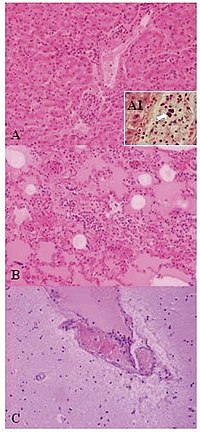
Photo from wikipedia
An EPS produced by Weissella confusa H2 was purified through Sephadex G-100, and the preliminary structure characteristics and biological activities of H2 EPS were analyzed. Molecular mass of purified H2… Click to show full abstract
An EPS produced by Weissella confusa H2 was purified through Sephadex G-100, and the preliminary structure characteristics and biological activities of H2 EPS were analyzed. Molecular mass of purified H2 EPS was 2.705 × 106 Da as measured with gel permeation chromatography (GPC). Composition of monosaccharides, nuclear magnetic resonance (NMR) spectroscopy spectroscopy and fourier transform infrared (FT-IR) showed that the EPS was a linear homopolysaccharide, mainly constituted of glucose and it is suggested that the EPS was dextran with α-(1 → 6) glycosidic bonds and a few α-(1 → 3) branches. Atomic force micrograph (AFM) and scanning electron microscopy (SEM) analysis of dextran further revealed sheets branched microstructure anchored with many irregular protuberances in aqueous solution. The XRD pattern reflected non-crystalline amorphous nature. In addition, the solubility, water-holding capacity, thermal property, rheological property and heavy metal chelating activity of the purified H2 dextran were determined. The dissolution percentage and water holding capacity of the dextran were 98.78 ± 1.37% and 426.03 ± 7.26%, respectively. The dextran exhibited good hydrophilicity, thermal stability and heavy metal chelating activity. Rheological studies exhibited rotational speed, pH, temperature, metal ions solutions dependent semiviscous nature. These results support its use as an additive in the food and environmental protection fields.
Journal Title: International journal of biological macromolecules
Year Published: 2022
Link to full text (if available)
Share on Social Media: Sign Up to like & get
recommendations!